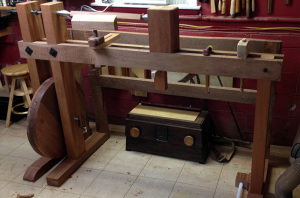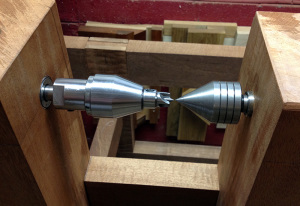Did I Just Make a Perpetual Motion Lathe?
Time for a treadle lathe update and something to make me go “hmmmmm”.
The lathe is almost done. I haven’t strung up the belt yet, but that is my next step. I’m afraid once I get it running, I’ll have a hard time finishing up all the little details and instead just start playing. I have already gotten a taste of this by installing the spindle and crank arm. Really once I finished “hanging” the flywheel and started it spinning there was very little work done because I just played around with adjustments the drive center. The flywheel is astonishing however and runs like I just created a perpetual motion machine.
I cranked it up and let it spin and I kid you not it was still ticking over on it’s own 3 minutes later at least. I have not technically trued up the wheel, but rather just cleaned up the bow sawn edge with a spokeshave roughly to my pencil line. It runs quite true with only a small hump in one quarter. However that small hump throws a bit more weight around and acts to give the wheel a little kick each rotation. That I think explains the seeming perpetual motion.
 So here is the head scratcher. Should I really focus on getting this wheel perfectly balanced? The way it runs now the momentum gets a little more energy with each rotation and requires an incredibly small amount of energy to keep it up to speed. If this were my electric midi lathe it would create a lot of vibration at higher RPMs and shake the body all over the place. With this lathe, I have a very massive frame and I doubt I will ever exceed 1000 rpm at the spindle and a much lower rpm at the wheel. When I had the speed cooking along at high speed with me kicking the treadle lightly once ever 1-2 seconds I felt no vibration in the headstock or the rails. I actually set a glass of water on the rails and got no ripples. So first of all, hooray for sturdy lathe body construction! So now I’m wondering if I can even introduce vibration into the frame due to this imbalance at my relatively low RPMs.
So here is the head scratcher. Should I really focus on getting this wheel perfectly balanced? The way it runs now the momentum gets a little more energy with each rotation and requires an incredibly small amount of energy to keep it up to speed. If this were my electric midi lathe it would create a lot of vibration at higher RPMs and shake the body all over the place. With this lathe, I have a very massive frame and I doubt I will ever exceed 1000 rpm at the spindle and a much lower rpm at the wheel. When I had the speed cooking along at high speed with me kicking the treadle lightly once ever 1-2 seconds I felt no vibration in the headstock or the rails. I actually set a glass of water on the rails and got no ripples. So first of all, hooray for sturdy lathe body construction! So now I’m wondering if I can even introduce vibration into the frame due to this imbalance at my relatively low RPMs.
Not being an engineer, I can’t help but wonder what I’m missing. Am I trying to impose modern machinery ideals onto a DaVinci design? I know that if I balance the wheel by removing that extra bit of stock I won’t be able to put it back on. Realistically it may not even make a difference in the perceived effort on my part while turning and the wheel will still be at least 60 lbs.
If you hadn’t guessed by now I’m really leaning towards leaving it out of balance to see just how that translates to performance once I chuck up wood and apply load via the gouge. For now it is too dang fun to crank it up and watch it spin effortlessly without slowing. I’m anxious to experiment a bit and see if the dreaded vibration creeps up after all.
Here is a short video I took showing the wheel in motion:
Sep 28, 2013 | Hark the wheel! She spins!! by RenaissanceWW on Keek.com
Its still going…
Sep 28, 2013 | It’s unstoppable! by RenaissanceWW on Keek.com



